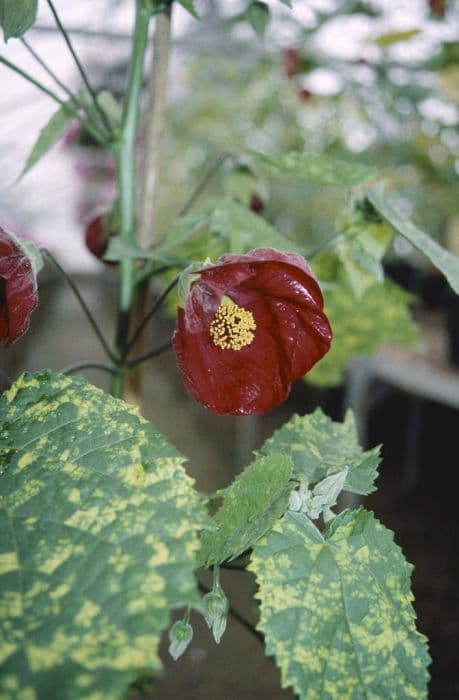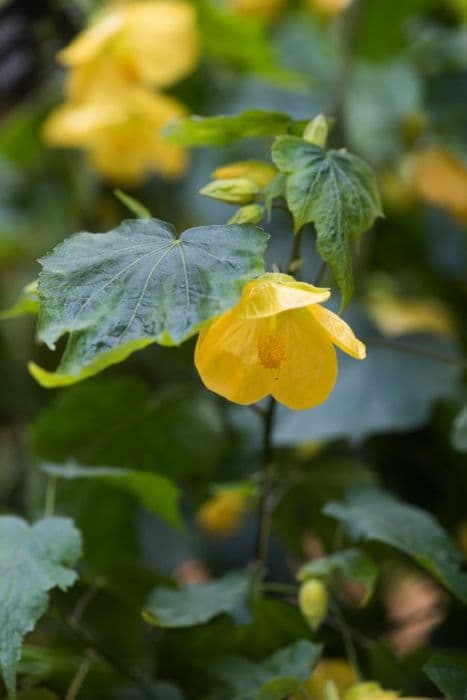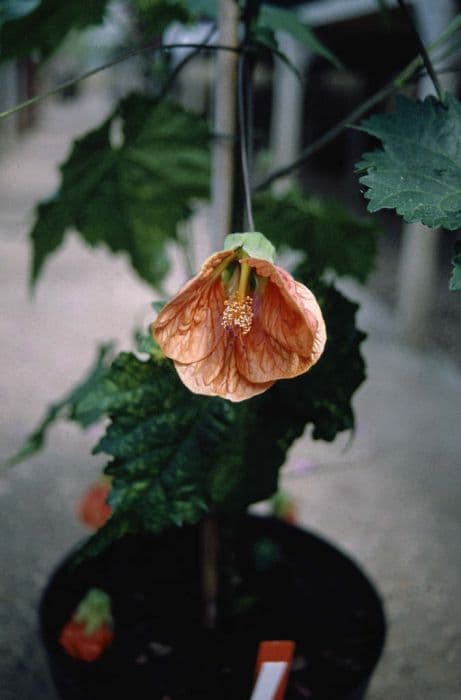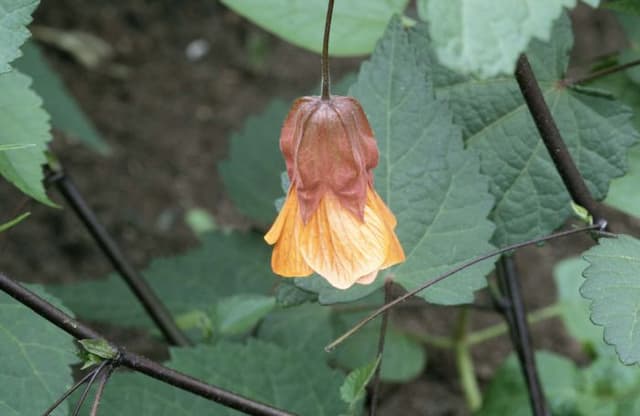Lacebark Hoheria 'Glory of Amlwch'

ABOUT
The 'Glory of Amlwch' is a visually striking plant, characterized by its attractive foliage and flowers. The leaves are glossy green and somewhat toothed, providing a lush backdrop for the star-shaped, white flowers that appear in abundance. These blooms cluster together in loose groupings, creating a soft and frothy effect that is quite eye-catching during the flowering season. The overall shape of the plant can be somewhat upright with branches that splay outwards, lending it a graceful, slightly spreading look. The blooms can have a subtle fragrance, which adds another layer of sensory appeal to the plant. Overall, 'Glory of Amlwch' exudes a delicate charm with its combination of shapely foliage and profuse, delicate blossoms.
About this plant
 Names
NamesFamily
Malvaceae
Synonyms
New Zealand Holly, Lacebark, Ribbonwood
Common names
Hoheria 'Glory of Amlwch'.
 Toxicity
ToxicityTo humans
Lacebark is not widely known to be toxic to humans. There are no well-documented cases of poisoning from this plant, and it is generally considered safe in terms of human toxicity. While it's always prudent to avoid ingesting plants that are not explicitly meant for consumption, lacebark does not have a reputation for being harmful if accidentally ingested. Any plant material, however, can potentially cause reactions in some individuals, due to allergies or sensitivities, and this could result in mild stomach upset or discomfort. If any part of the plant is ingested and adverse symptoms are observed, it is advisable to seek medical attention.
To pets
Lacebark is not commonly reported to be toxic to pets. There is a lack of evidence pointing to any serious health risks associated with pets consuming this plant. Like many plants, it may not be intended for pet consumption, and eating non-food plants can sometimes cause mild digestive upset in animals, such as vomiting or diarrhea. Generally, lacebark is not considered a threat to pets. However, as with any non-food plant, it is still wise to prevent pets from eating it, as individual animals can have unique sensitivities. If you suspect your pet has ingested lacebark and is showing signs of distress, it is best to consult a veterinarian.
 Characteristics
CharacteristicsLife cycle
Perennials
Foliage type
Semi-deciduous
Color of leaves
Green
Flower color
White
Height
10-15 feet (3-4.5 meters)
Spread
6-10 feet (1.8-3 meters)
Plant type
Shrub
Hardiness zones
8
Native area
New Zealand
Benefits
 General Benefits
General Benefits- Attractive foliage: Hoheria 'Glory of Amlwch', commonly known as Lacebark, has glossy green leaves that add visual appeal to gardens.
- Flowering interest: It produces clusters of white flowers during the summer, which enhance garden beauty and provide a focal point.
- Habitat for wildlife: The flowers attract pollinators such as bees and butterflies, supporting biodiversity.
- Privacy screening: With its dense growth habit, Lacebark can be used to create private garden spaces or screen unsightly areas.
- Low maintenance: It is generally easy to care for and does not require complex gardening skills.
- Drought tolerance: Once established, Lacebark is reasonably tolerant to dry conditions, making it suitable for various climates.
- Adaptability: It can adapt to a range of soil types, provided the soil is well-draining.
 Medical Properties
Medical PropertiesThis plant is not used for medical purposes.
 Air-purifying Qualities
Air-purifying QualitiesThis plant is not specifically known for air purifying qualities.
 Other Uses
Other Uses- Ecological Support: Hoheria provides nectar and pollen for bees and other pollinating insects, contributing to the biodiversity of an area.
- Fabric Dyeing: The bark and leaves of Hoheria may be used to create natural dyes for textiles, offering varying shades depending on the mordant used.
- Privacy Screening: Hoheria can be planted in rows to form a dense hedge, providing privacy in gardens and landscapes.
- Windbreaks: Due to its robust and fast-growing nature, Hoheria can be utilized to create windbreaks around properties to reduce soil erosion.
- Sustainable Crafts: Dried branches of Hoheria could be used in basketry and other sustainable craft activities.
- Garden Sculpture: The strong wood from mature Hoheria trees can be used for garden sculptures or decorative walking sticks.
- Soil Stabilization: Hoheria's root system can help to stabilize slopes and prevent landslides in hilly areas.
- Wildlife Shelter: Dense foliage provides shelter for birds and small mammals, offering a safe habitat within gardens or parks.
- Photography Subject: The attractive flowers and form of Hoheria make it a popular subject for garden and nature photographers.
- Environmental Education: Schools and educational programs can use Hoheria as a tool for teaching children about native plant species and their role in local ecosystems.
Interesting Facts
 Feng Shui
Feng ShuiThe Lacebark is not used in Feng Shui practice.
 Zodiac Sign Compitability
Zodiac Sign CompitabilityThe Lacebark is not used in astrology practice.
 Plant Symbolism
Plant Symbolism- Resilience: Hoheria, commonly known as Lacebark, is known for its toughness and ability to withstand challenging conditions, symbolizing the resilience and endurance to overcome adversity.
- Purity: With its delicate white flowers, Lacebark is often associated with purity and innocence, representing cleanliness of thought and deed.
- Innovation: The versatile use of Lacebark by indigenous Māori for medicinal purposes and its unique inner bark, which can create a lace-like fabric when washed, may symbolize creativity and ingenuity.
- Protection: Traditionally, the inner bark of the Lacebark provided insulation and waterproofing for clothing, symbolizing shelter and safety.
- Healing: Lacebark possesses certain medicinal qualities, which makes it a symbol of healing and restorative properties.
 Water
WaterFor Lacebark, which is the common name for Hoheria 'Glory of Amlwch', water the plant deeply and thoroughly to ensure that the moisture reaches the roots. The plant prefers consistently moist soil, so watering it once or twice a week might be necessary, especially during dry spells. During the growing season in spring and summer, keep the soil slightly more moist but reduce watering frequency in the fall and winter months. An average size Lacebark may need approximately 1 to 2 gallons of water each week, depending on the weather and soil drainage.
 Light
LightLacebark thrives in a position with full sun to partial shade. An ideal spot would provide morning sunlight with some afternoon shade, especially in hotter climates. Ensure that it is planted where it will receive at least 4 to 6 hours of sunlight daily for optimum growth and flower production.
 Temperature
TemperatureLacebark is hardy and can tolerate a range of temperatures, from as low as 20°F in winter to highs reaching around 80°F in summer. While the plant can survive brief periods of colder temperatures, prolonged exposure to under 20°F may cause damage. The ideal temperature range for Lacebark to thrive is between 60°F and 75°F.
 Pruning
PruningPrune Lacebark to maintain its shape and remove any dead or damaged branches. The best time to prune is in late winter or early spring before new growth starts. Pruning once a year is typically sufficient, but occasional trimming might be necessary to keep the plant looking tidy. Always use clean, sharp pruning shears to make clean cuts.
 Cleaning
CleaningAs needed
 Soil
SoilThe Lacebark prefers well-draining soil rich in organic matter with a pH of 5.5 to 7.5. A mix comprising loamy soil, compost, and some perlite or coarse sand is ideal for maintaining good drainage and fertility.
 Repotting
RepottingLacebark should be repotted every 2 to 3 years or when it has outgrown its current pot, using fresh soil mix to replenish nutrients and encourage growth.
 Humidity & Misting
Humidity & MistingLacebark thrives in moderate to high humidity levels, ideally between 50-60%, but it is quite adaptable to the typical range found in household environments.
 Suitable locations
Suitable locationsIndoor
Ensure bright, indirect light and maintain consistent humidity.
Outdoor
Plant in a sheltered spot with well-draining soil and some afternoon shade.
Hardiness zone
8-11 USDA
 Life cycle
Life cycleThe Lacebark or Ribbonwood 'Glory of Amlwch' begins its life cycle as a seed, which germinates in moist, well-drained soil, typically in the spring. Seedlings emerge with a set of cotyledons before true leaves develop, as the young plant establishes its root system. As it grows into a juvenile, it develops distinctive serrated leaves and a strong, upright stem. Upon reaching maturity, which can take several years, the Ribbonwood produces clusters of fragrant white flowers in late summer to autumn, attracting pollinators. After pollination, the flowers develop into small capsules that contain seeds, which are dispersed by wind or animals. The plant enters a period of senescence in its later years, where growth slows, and it may become more susceptible to environmental stresses, but it can live for several decades under optimal conditions.
 Propogation
PropogationPropogation time
Spring-Early Summer
The Hoheria 'Glory of Amlwch', commonly referred to as Lacebark, is most commonly propagated by semi-hardwood cuttings. To propagate Lacebark, the best time to take cuttings is in late summer. Choose healthy semi-hardwood stems from the current season's growth, and cut sections about 4-6 inches (10-15 cm) long, making sure each cutting has several leaf nodes. Remove the leaves from the lower half of the cutting and dip the cut end in rooting hormone. Plant the cutting in a pot filled with a mixture of peat and perlite or sand to provide good drainage. Keep the cuttings moist and in a warm environment with indirect light until roots develop, which often takes several weeks. Once the cuttings have rooted, they can be transferred to individual pots and eventually planted out into the garden.





![Abutilon [Yellow Trumpet]](/_next/image?url=https%3A%2F%2Fplants-admin.emdemapps.com%2Fimages%2Fplants%2F%2Fimages%2F604b5caa8b4fb.png&w=640&q=75)


